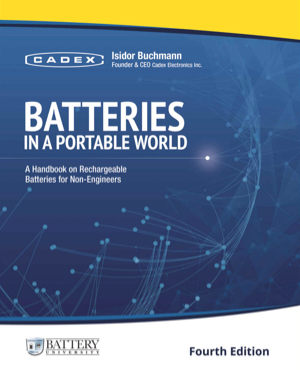Medical technicians have discovered that most defibrillators batteries had over 90% capacity left when the two-year expiry date called for replacement. This had led to discarding perfectly good batteries, escalating operational costs and stressing the environment. A manager of the Energy Storage Research Program at DOE reported that “every year roughly one million usable lithium-ion batteries are sent for recycling.” In spite of this frivolous replacement policy, a US FDA survey says that “up to 50% of service calls in hospitals surveyed relate to battery issues.” Healthcare professionals at AAMI say further that “battery management emerged as a top 10 medical device challenge.” A bio-med whistle-blower said, “Batteries are the most abused components. Staff care little about them and only do the bare minimum. References to battery maintenance are vague and hidden inside service manuals.”
Batteries should receive the same treatment as a critical part in a machine or an aircraft where wear and tear falls under strict maintenance guidelines. This is not happening and batteries receive special privileges, partly because they are considered “uncontrollable.” Batteries can and should be checked and this is possible with a battery analyzer that checks capacity and internal resistance. Capacity refers to storage capability governing runtime and internal resistance enables power delivery.
Battery analyzers have been used for many years but checking large volume of batteries with a full charge/discharge cycle is not always practical and new test methods are being developed. One such advancement is Diagnostic Battery Management (DBM) by Cadex that provides an instant status report by reading the FCC (full charge capacity) of a smart battery.
FCC readings are in- and out-flowing coulombs. Stored in the SMBus battery for instant readout, FCC represents battery state-of-health (SoH). As with most tracking methods, however, inaccuracies develop with time because of random discharges. This can be solved by giving the battery a PASS when the FCC dwells above the user-set capacity threshold that is typically 80%. Calibration is required if FCC falls below this number. A calibration applies a charge/discharge/charge cycle to read the capacity of the chemical battery. If the capacity is below 80%, a replacement is needed. Such a system doubles battery life and improves system reliability as it allows the full service life of each battery.

DBM installed in a Cadex charger or analyzer makes battery performance transparent to users (chart on right). Custom battery adapters enable easy interface to different battery types and the Wide Area Network displays data to fleet managers.
Placing an SMBus battery into a charger or analyzer provides an instant SoH readout. Each service updates the reading to maintain history. Come budget time, the operator simply calls up packs with low capacity for replacement. This is normally 80%. Spare charge at the end of a day can also be verified and a battery should have a minimum of 10% reserve. If the spare charge is tight, the pass/fail threshold should be raised; with plenty of reserve the battery can drop to a lower capacity threshold before a replacement is needed. Knowing the capacity and remaining charge assures a reliable energy delivery for all applications. Equally important, DBM establishes a critical balance between risk management and economy.
Risk reduction is not the only benefit. A modern battery analyzer typically pays back in less than one year by keeping the battery in service longer and reducing unexpected failures. Device manufacturers support battery maintenance because it eliminates under-performing batteries and reduces the number of devices sent for repair. Well-performing batteries reflect positively on the equipment; a win-win situation for all parties. Best of all, the DBM is easy to implement and operate. The availability of DBM in Cadex battery analyzers and chargers is scheduled for 2017.
Only with DBM does the battery become a reliable, safe, cost efficient and environmentally sustainable power source. Building a super battery is incomplete without considering workforce-to-retirement. DBM does this by combining known technologies into a powerful supervisory system. The smartphone is similar in that it also uses existing technologies to build an influential device that changed society.
Cadex Electronics has been a technology provider in batteries for 35 years. We are engineering oriented and manufacture specialty battery packs and chargers as well as diagnostics and life cycle management systems. With offices in Canada and Germany, we help the world reduce the dependence on fossil fuels to protect the environment. Cadex does ongoing research in diagnostic battery management and sponsors www.BatteryUniversity.com, an educational website on battery.
About the Author
Isidor Buchmann is the founder and CEO of Cadex Electronics Inc. For three decades, Buchmann has studied the behavior of rechargeable batteries in practical, everyday applications, has written award-winning articles including the best-selling book “Batteries in a Portable World,” now in its fourth edition. Cadex specializes in the design and manufacturing of battery chargers, analyzers and monitoring devices. For more information on batteries, visit www.batteryuniversity.com; product information is on www.cadex.com

Comments
Looking for comments from the previous website?
Comments from the previous website are not compatible with our new commenting system but we have preserved them so our users can still reference and make use the information in them.
